Home demolitions — in particular historic home demolitions — have flooded local review authorities in recent months, testing historic commissions, architects and homeowners as they weigh the importance of character and preservation in a rapidly changing Island real estate market.
The Martha’s Vineyard Commission, which has authority to review the demolition of historic homes over 100 years old as developments of regional impact, has seen a significant recent uptick in demolition referrals since the pandemic began, often meeting weekly instead of bi-weekly to handle the load.
Island towns have referred 11 historic home demolitions to the MVC since the fall of 2020 when large-scale construction resumed, including the Harman House on the Edgartown harbor, five cottages in Oak Bluffs and a summer cottage on the Edgartown Great Pond. Nine of those have come since April of this year. “There’s been a recent wave,” said commission DRI coordinator Alex Elvin.
The homes have much in common. Nearly all are mid-sized, eclectic summer homes dating to the turn of the 20th century, with unique historical features, peculiar room layouts and little insulation. What they lack in master suites or modern wiring they make up for in colorful wainscoting and window panes. They have few amenities, but are functional and often close to code. While homeowner/applicants range from year-round Islanders to new seasonal residents, nearly every proposed replacement structure has been larger than the original home.
In interviews, commissioners, commission staff, building inspectors and members of town historic commissions pointed to different factors to explain the spike in teardowns — although all hinted that it could be a side effect of the pandemic, which has caused real estate prices to skyrocket and inventory to collapse. In turn, buyers purchased properties planning future teardowns or extensive renovations, particularly as the Vineyard became a popular pandemic refuge.
Historic commissions are faced with an unprecedented backlog, grappling with legitimate desires to winterize old properties as the Island becomes more year-round, and requests to build something quite different in their place.
“The property is worth more than the house,” explained Pam Melrose, who serves as chairman of the Oak Bluffs historic commission. “But you can’t put the house back once it is taken down.”
In Edgartown, building inspector Reade Milne said there have been 16 full demolition requests since January of 2020, and already 12 in 2021 — significantly more than the 11 requests in 2018 and eight requests in 2019. Ms. Milne said most, if not all, of the requests were to demolish a smaller home in order to build a larger structure on the same property.
“There has definitely been an uptick in demos,” Ms. Milne wrote to the Gazette in an email. “Anecdotally I have seen a trend towards demolishing smaller homes in typically year-round neighborhoods (Pinehurst and Curtis Lane, for example) to make way for larger houses.”
While Tisbury building inspector Ross Seavey said he had not seen a noticeable increase in historic home demolition referrals in the town, he noted a significant number of meetings with contractors in which they designed alterations to historic homes in order to stay beneath the threshold for commission review.
A much-debated footnote in the commission DRI checklist defines demolition as “any act of pulling down, destroying, removing or razing any building or a portion thereof,” classifying a “portion” as either 50 per cent or more of the floor area of the home, or 25 per cent of the facade.
In Oak Bluffs, a longstanding proposal to demolish the dilapidated but historic Old Variety Store at the head of Circuit avenue was withdrawn from commission review after developers altered their plans, according to Mr. Elvin.
“They actually reduced the square feet to close to one foot below the threshold for the DRI checklist,” Mr. Elvin said. “It was a technicality, so we couldn’t end up taking that one.”
The project, which includes an upstairs apartment and the possibility of a restaurant on the bottom floor, remains under review at the town level.
After the Mill House — an 18th century home on the Vineyard Haven harbor — was razed in 2019 without review, the commission has beefed up its procedures for historic home demolitions, hiring a full-time historic preservation planner and creating a review matrix to analyze historic structures.
But at recent commission meetings, the historic home trigger has prompted fraught debate among commissioners, as an effort to broaden the demolition definition to include a stricter limit on alterations, lowering the required square footage, has stalled. Fred Hancock, who has headed a committee charged with updating the DRI checklist, said changes remained on the table, including a mechanism to handle historic demolitions that seek to convert summer cottages to larger, winterized residences.
“We are going to see way more of that, I fear,” Mr. Hancock said in an interview. “It’s one of the paradoxes of life, for people to come to the Island and then try to make it look like the place they came from.”
But the question of reviewing structures proposed in place of demolished buildings has also become a touchy subject at commission meetings. Although the commission can weigh proposed replacement buildings as part of their demolition review, applicants are not required to submit the proposal, leading to gray areas.
“That’s where we’re really being instructed to be careful, because . . . you don’t mind the demo. You mind what’s coming. And that’s not what we’re doing here,” commissioner Ted Rosbeck said during a recent deliberation over a historic demolition proposal in Edgartown, which would replace an existing, 2,000-square-foot summer cottage on the Great Pond with a 7,000-square-foot home, including a tennis court and pool.
The commission voted not to review the demolition, arguing it would have had no control over the project if the existing structure wasn’t historic. But other commissioners felt the proposed home represented a changing Island character issue, falling directly under the commission’s purview.
“It’s unfortunate that it seems like we’re moving towards not looking at the replacement as a part of the review of demolitions of historic structures,” commissioner Ben Robinson said at the meeting. “There is definitely a regional impact to that type of structure being built on our coastal ponds and on the Island . . . and that’s important to weigh, as we think of the values of materials assembled in a place, with labor, that functions as a home, versus demolishing it, dumpstering it, and removing it. And with it, the history goes as well.”
On Thursday night, the commission was scheduled to decide on two historic home demolitions in Oak Bluffs. One, located at 19 Mill Square Road on East Chop, is a gabled house overlooking East Chop Drive in the Oak Bluffs Highlands. A second, at 112 Dukes County avenue — is being retroactively reviewed after it was torn down this spring.
“It’s always a huge decision,” Ms. Melrose said.










Comments (34)
Comments
Comment policy »